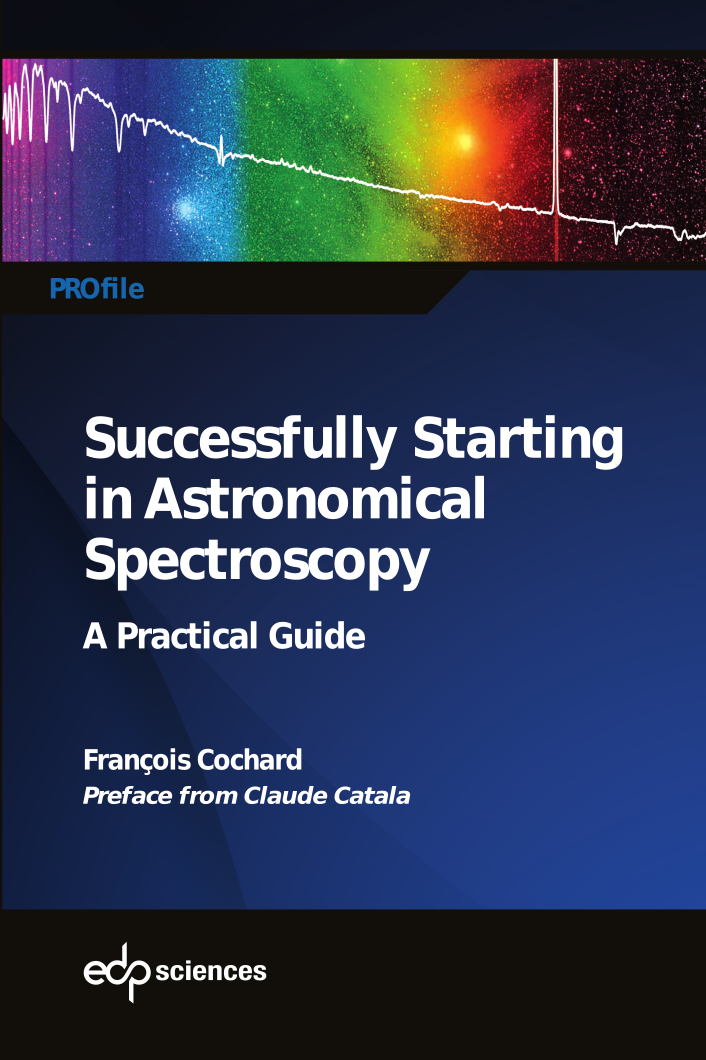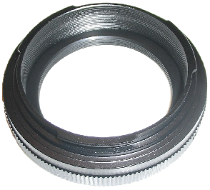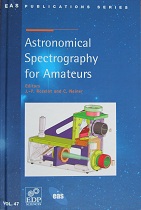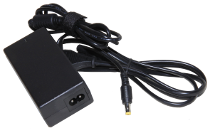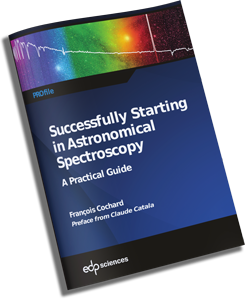DC0029 – Spectroscopy – practical guide
39,00 € incl. VAT - 36,97 € excl. VAT
Succesfully Starting in Astronomical Spectroscopy – A Practical Guide.
This book has been written by François Cochard, general manager of Shelyak Instruments. It is also available in french : Guide pratique pour (bien) démarrer en spectroscopie astronomique
This is a practical guide to help you starting ins Astronomical Spectroscopy.
Additional information
| Weight | 39 g |
|---|
Amateur interest in Astronomical spectroscopy is on the rise. More and more amateur astronomers are diving into the adventure. Getting a star spectrum, today is easily feasible, with modest equipment – if you have a method, and go step by step. This book is a guide; it is very practical. It addresses all the issues required to quickly assist you in obtaining quality spectra with a slit spectroscope. We talk about astrophysics and optics, but it is not an astrophysical or optical course. No prerequisite is needed.
A big part of the book is dedicated to the setup of your equipment and to obtaining spectra in the field. This is often where beginners face problems: one needs to make several devices (telescope, spectroscope, camera…) work together. Little by little, you’ll learn how to get your first spectra, to perform data reduction, and to look at your spectra with more and more expectations – up to the moment when you realize that you’re doing real science.
« The book you are about to read is remarkable in the sense that it makes the foundations of astronomical spectroscopy accessible to all and provides practical advice for its application. It will without doubt give you the desire to embark on this great adventure, and provides you the means to achieve it. »
extract from the preface written by Claude Catala, President of the Observatoire de Paris
Chapter 1 • Entering the Realm of Amateur Astronomical
Spectroscopy
1.1 Spectrography, Spectrometry, Spectroscopy
1.2 What Does a Spectrum Look Like ?
1.3 The Missing Link
1.4 Short History
1.5 Amateur Spectroscopy Today
1.6 Starting Spectroscopy
Chapter 2 • Light
2.1 Light is a Wave
2.2 Light is a Particle
2.3 Making Light
2.4 Shifting a Spectrum
2.5 What a Human Eye Sees
2.6 Atoms and Molecules
Chapter 3 • What Light Tells us about Stars
3.1 The Light of an Ordinary Star
3.2 Each star has its Own Spectrum
3.3 Observing at Di#erent Resolutions
3.4 Limiting Magnitude
3.5 A Moving Sky
3.6 Time Evolution
3.7 Not only Stars
3.8 Basic Chemistry
Chapter 4 • What can I Observe with my Instrument ?
4.1 The Basic Questions
4.2 Many Types of Observations
4.3 What Physical Phenomena to Observe ?
4.4 Start with Low Resolution
4.5 Start with Di#erent Spectral Types
4.6 Organize your Observation
Chapter 5 • Optical Principles of a Spectroscope
5.1 Re#ection, Refraction and Diffraction
5.2 Prism and Grating
5.3 Refresh of Geometric Optics
5.4 Refracting and Re#ecting Telescopes
5.5 Architecture of a Spectroscope
5.6 A Real Example: Alpy 600
5.7 Another Example: Lhires III
5.8 Guiding Stage
5.9 Calibration Light
5.10 Échelle Spectroscopes
5.11 Fibre Optic
Chapter 6 • Main Parameters of a Spectroscope
6.1 Resolution and Resolving Power
6.2 Focal ratio (F-ratio)
6.3 Magni#cation and Sampling
6.4 Resolution and Dispersion
6.5 Spectral Range
6.6 Spectral Domain
6.7 E#ciency
6.8 Mechanical Backfocus and Fastening
6.9 Telescope and Sky Quality
6.10 Ajusting the Con#guration
6.11 Keep it Simple !
Chapter 7 • CCD Cameras and Acquisition Softwares
7.1 A Wide Variety of Choices
7.2 Image Detector or Light Detector ?
7.3 Acquisition Software
7.4 Some Simple Manipulations
Chapter 8 • Adjusting the Spectroscope
8.1 Which Light Source ?
8.2 Install the Acquisition Camera
8.3 Focusing and Orientation
8.4 Blue on Left, the Red on the Right
8.5 Choice of the Range of Wavelength
8.6 Setting up the Guiding Camera
Chapter 9 • Physical Measurements and Data Reduction
9.1 Your mission: the Spectral Profile
9.2 Do not put the Cart before the Horse
9.3 Intensity and Wavelength
9.4 Distinguishing Technicalities and Science
9.5 Systematic and Random Errors
9.6 Signal-to-Noise Ratio
9.7 The Steps to Reduce the Data
9.8 Catalogues of Reference Stars
9.9 An observation is a Set of Images
Chapter 10 • First Spectroscopic Observation: The Sun
10.1 Reference Images
10.2 Data Reduction
10.3 Wavelength Calibration
10.4 Correction for the Instrumental Response
Chapter 11 • Mastering the Telescope
11.1 Mastering the Mount
11.2 Calculation of the Image Field
11.3 Understand the Telescope Motion
11.4 Pointing at a Star
11.5 Autoguiding
Chapter 12 • Installing the Spectroscope on the Telescope
12.1 Stiff Mechanical Match
12.2 Orientation of the Spectroscope
12.3 Balancing and Cables Management
12.4 Plugging in
12.5 Focus Guiding and Telescope
12.6 Last Checks
12.7 At the Beginning of the Night
Chapter 13 • Spectroscopic Observation of another
13.1 Starting the Observation
13.2 The Reference Star
13.3 Point to the Target Star
13.4 Take all the Reference Images
13.5 Data Reduction
13.6 Going Beyond
Chapter 14 • Quality of the Spectrum
14.1 Read the Outcome of the Calculation
14.2 Compare with other Observers
14.3 Verify the Wavelength Calibration
14.4 Non-uniform Intensities in the Observations
14.5 Measure of the SNR
14.6 Level of the Signal for your Instrument
Chapter 15 • Ready for the Adventure
15.1 The Typical Observing Session
15.2 Improve your Observations
15.3 Improve the Quality of the Data
15.4 Improve your Productivity
15.5 Share your Results
15.6 Spectra of Professional Quality
255 pages
EDP Sciences – PROfile

